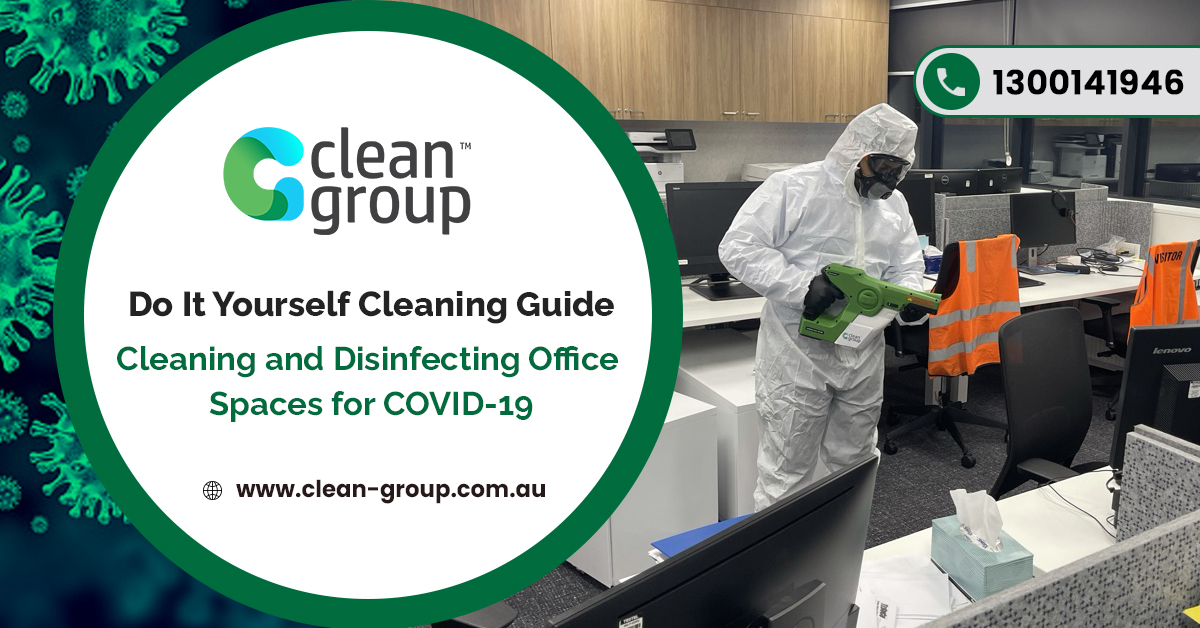When an infected person sneezes or coughs, COVID-19 spreads by respiratory droplets – an individual can contract the virus by touching a virus-infected object or surface and then touching their nose, mouth, or eyes.
Implementing the correct disinfecting and cleaning steps in your office space is a vital approach to safeguarding workers and others from the danger of COVID-19 infection. Covid-19 cleaning services are a must solution for all types of covid deep cleaning solutions.
In order to eradicate the COVID-19 virus, a mixture of disinfection and cleaning is the most effective method.
Cleaning office spaces at least once a day is strongly recommended. In some cases, more regular cleaning might be necessary – if your office space works in shifts, for example, cleaning should be done in between shifts. Furthermore, if employees share equipment, it needs to be cleaned between uses whenever possible.
Cleaning with water and detergent is enough to get the job done, so you don’t need to be excessive.
Surfaces can be disinfected after they’ve been cleaned -the probability of contaminated objects being present determines when and how often your office space, or specific surfaces, must be disinfected.
This includes any time there’s been a case or suspicion of COVID-19 in the office, as well as workplaces with a large number of customers, employees, or visitors who are likely to come in contact with various surfaces.
Essential Factors to Remember Regarding the Covid-19 Virus
- Coronaviruses on objects and surfaces expire in a matter of hours to days. The time the virus remains on the things is reduced as temperatures rise and as it is exposed to sunshine.
- Cleaning surfaces with water and soap on a regular basis removes germs and filth. It reduces the probability of COVID-19 infection spreading.
- Disinfectants are chemicals that kill microorganisms on surfaces. You can further reduce the danger of infection transmission by eradicating bacteria on a surface after washing. Disinfectants approved by health officials are a crucial aspect of lowering the risk of COVID-19 infection. Alternative sanitisers (for example, bleach mixed with water or 70% alcohol solutions) may be used if the disinfectants are in short supply.
- Disinfectants should be stored and used responsibly and as per the label. Mixing bleach and other disinfectant and cleaning solutions can produce vapours that are potentially hazardous to inhale.
- Do not overuse disinfectants or other materials or store them. This could lead to a shortage of acceptable products for other people to use in a crisis. When disinfecting and cleaning, always use gloves that are suitable for the chemicals being used. Depending on the situation and product, additional personal protective equipment (PPE) may be required.
- Maintain social distance, wear facial covers, and practice proper preventative hygiene, such as regular hand washing and the use of alcohol-based (at least 60% alcohol) hand sanitisers when soap and water are unavailable.
Solutions for Disinfecting and Cleaning
Disinfection and cleaning are two distinct processes:
Cleaning is using a water and detergent solution to physically get rid of germs (viruses and bacteria), grime, and dirt from objects. A detergent is a type of surfactant that works with water to break up grease and oil. It works with anything labelled as a detergent.
Disinfection is the process of killing germs (viruses and bacteria) on surfaces with chemicals. Cleaning is necessary before disinfection because grime and dirt might impair the disinfectant’s effectiveness to kill bacteria.
On hard surfaces, disinfectants comprising 70% alcohol, chlorine bleach, quaternary ammonium compounds, or oxygen bleach are appropriate (that is, places where any spilled liquid pools and doesn’t soak in).
On the box, these are labelled as “disinfectant.” If there is any doubt, the substance’s manufacturers or importing providers must be contacted for assistance.
Hard surfaces should be disinfected with a 1,000 ppm bleach (sodium hypochlorite) solution, according to health officials.
When cleaning after an individual, with a suspected or confirmed case of COVID-19, who has previously been at the office, a combination of disinfectant and cleaning is the most efficient in eliminating the COVID-19 virus.
Disinfectants must have enough contact time to be successful.
Physical cleaning with detergent and water is sufficient for ordinary office space cleaning in non-healthcare settings. The COVID-19 virus cannot be killed by water or physical exertion alone.
Determining Which Areas Need to be Cleaned and Disinfected
Some surfaces can be cleaned simply with soap and water. Objects and surfaces that are not commonly touched, for example, must be cleaned but do not require disinfection.
Does Your Office Space Have an Outdoors Area?
Outdoor areas usually only need to be cleaned on a regular basis and do not need to be disinfected. Spraying disinfectants on pavements and in parking lots is a waste of disinfectant supplies and has not been proved to minimize the risk of COVID-19 infection to the general public. Cleaning and hygiene procedures for outside places should be maintained.
On outdoor hard surfaces and things that are frequently touched by several individuals, disinfectants can be used efficiently, effectively, and safely.
Has Your Office Space Been Unoccupied for the Past Seven Days?
If your office space has been unoccupied for seven days or more, all that is required to reopen the space is your regular cleaning, which is due to the fact that the virus that causes COVID-19 has never been observed to live on surfaces for longer than this period of time.
When opening public buildings and areas that have been closed for long periods of time, there are various public health factors to consider, not just COVID-19.
Take steps to assure the safety of your office’s water system, for instance. Cleaning ventilation systems, aside from basic maintenance, is not required to reduce the risk of Covid-19.
Determining What Areas You Need to Disinfect
Following your regular office cleaning practice, disinfect commonly touched surfaces and items with a product from approved COVID-19-resistant products.
Are you disinfecting or cleaning a nonporous, hard object such as metal, glass, or plastic?
If the surface is suitable, you may use diluted household bleach solutions and pay close attention to any personal protective equipment (PPE) that might be required for safe disinfection application, as well as the manufacturer’s advice for any added dangers.
A few of the things you need to disinfect regularly in your office space include:
- Doorknobs
- Tables and desks
- Chairs
- Light switches
- Handles
- Phones
- Countertops
- Sinks and faucets
- Toilets
- Keyboards
- Computers or laptops
- Touch screens
- Coffee cups
- Vending machines
Different surfaces and things are going to be touched often by many people in every office. Disinfect these objects and surfaces as needed. Transit stations, for instance, have special disinfection and cleaning instructions.
Are you cleaning or sanitizing soft, porous materials or products such as carpets, chairs, or rugs in office areas?
Soft, porous substances are more difficult to disinfect than hard, non-porous surfaces. Porous and soft items that are not regularly touched must only be laundered or cleaned according to the object’s label’s instructions, using the warmest water setting possible.
How Should You Clean and Disinfect Your Office Space?
Follow the guidelines on the product label for every surface, along with any personal protective equipment you might have to wear to safeguard yourself against chemicals.
After cleaning with your space detergent, use a disinfectant.
If disinfectants are necessary, make sure they are COVID-19 virus-resistant. To use them securely and successfully, follow the directions. Before drying any surfaces with a clean cloth to kill germs, dwell periods – the length of time a substance must be wet on an object – are required.
Start with higher-up objects or surfaces and work your way down to the floor. This procedure makes sure that any dust, debris, or particles drop to the floor, which is then cleaned last.
Clean objects and surfaces that aren’t touched often first.
Work your way up to cleaning things that are regularly touched and have a larger potential for contamination (such as toilets and door handles).
Going from a dirty location to a clean area is not a good idea. This increases the possibility of polluting the cleaned area and ensures that no products or surfaces are contaminated.
After each usage, wash the mop heads and cloths.
After you’re done, wash and dry your hands.
When disinfecting or cleaning, use household gloves to ensure that the cleaning chemicals do not damage your hands. When you’re done, wash your hands and then wash and dry the reusable gloves.
If you’re wearing disposable gloves, take them off after each usage, toss them in the trash, and then wash and dry your hands.
Safety Precautions When Cleaning Your Office Space
- Before cleaning with fluids on or around electrical fittings or equipment, disconnect the equipment and cut off the power supply if possible.
- Read the disinfectant or detergent label and follow the manufacturer’s instructions.
- Get a copy of the disinfectant or detergent’s Safety Data Sheet (SDS) and familiarize yourself with its composition.
- Wear the proper personal protective equipment (PPE) as specified on the SDS and label.
The Bottom Line
This advice is for everyone who works in an office space, whether you manage the business, are an employee, or a customer/client. To limit our chance of exposure to the virus that creates COVID-19, we must all work together to reopen society by practising social distancing and other everyday practices.
Reopening all offices officially also relies heavily on public health efforts, such as expanded virus testing, isolation, social distancing, and tracking how someone sick may have infected others.
To reduce our risk of exposure to COVID-19, we must all work together to reopen office spaces permanently, using suggested best practices and maintaining safe daily habits; keep in mind that we’re all in this together!

